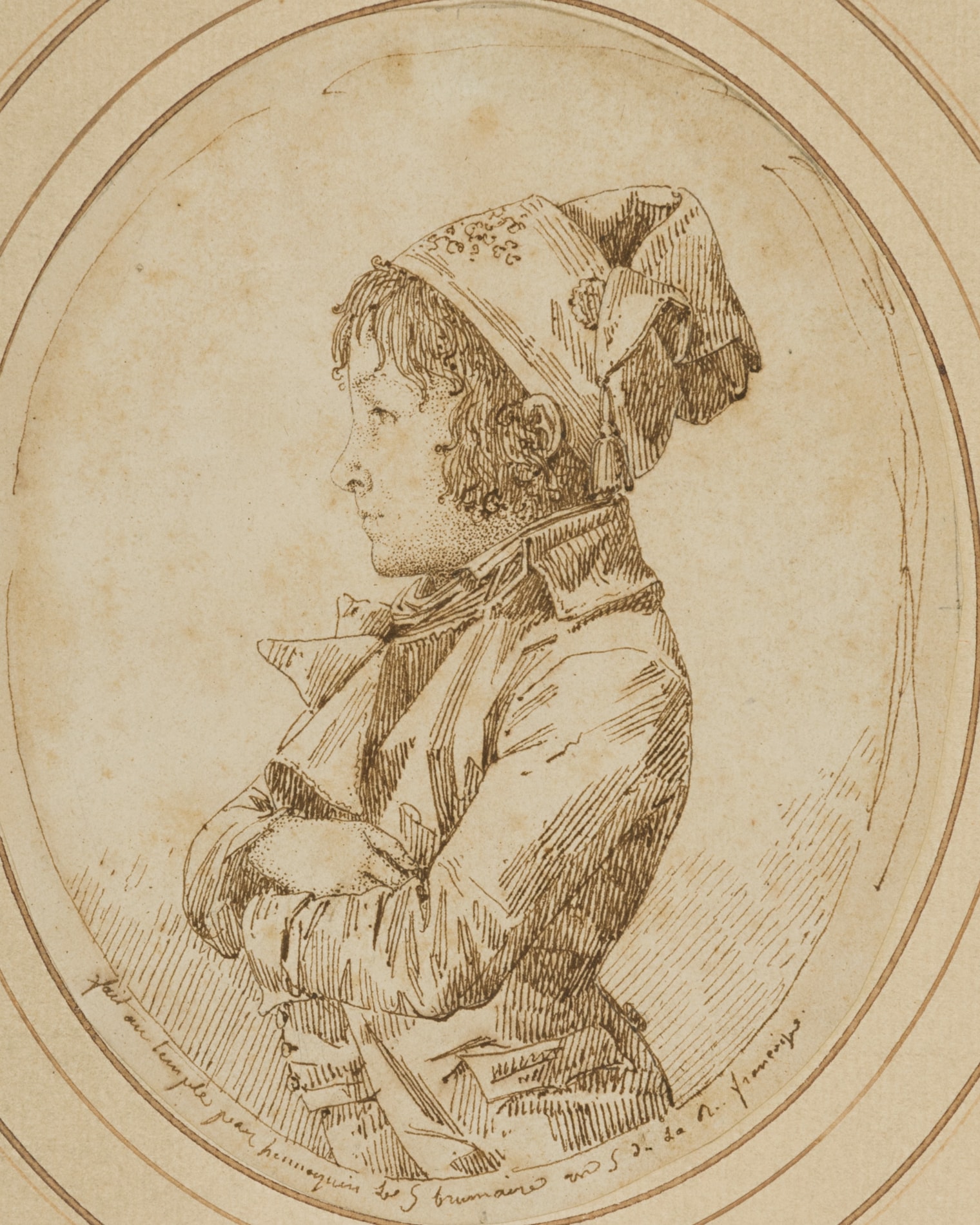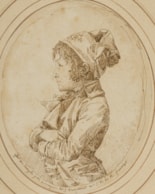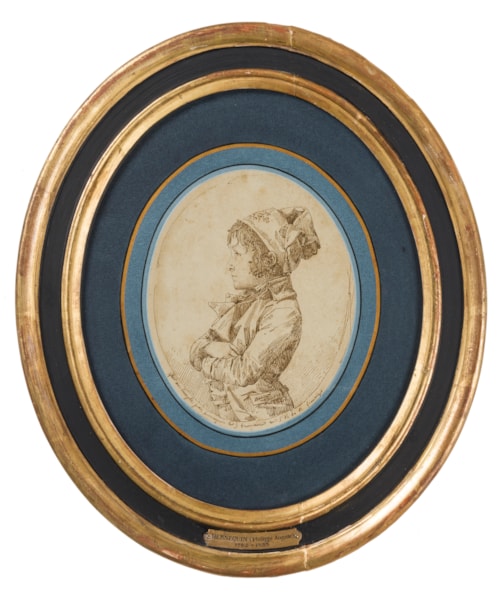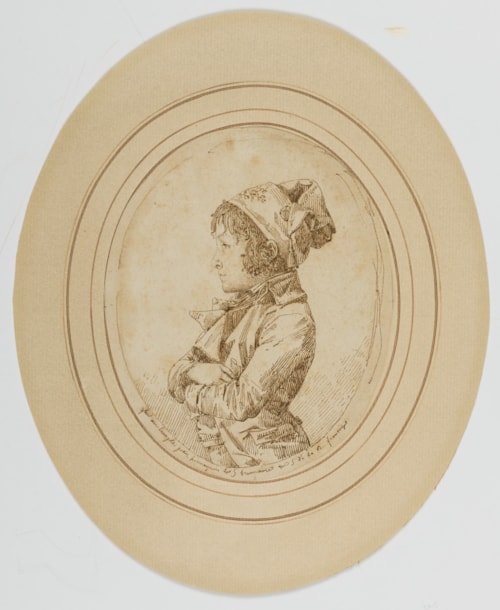Philippe-Auguste HENNEQUIN
(Lyon 1762 - Leuze 1833)
A Profile Portrait of a Young Boy in Revolutionary Costume
Sold
Pen and brown ink, with framing lines in brown ink.
Signed, dated and inscribed fait au temple par hennequin le 5 brumaire an 5 de la R.. française in the lower margin.
Further inscribed portrait fait dans la Prison du Temple par / Hennequin en l’an 5 on a piece of paper pasted onto the old backing board.
160 x 132 mm. (6 1/4 x 5 1/4 in.) at greatest dimensions.
Signed, dated and inscribed fait au temple par hennequin le 5 brumaire an 5 de la R.. française in the lower margin.
Further inscribed portrait fait dans la Prison du Temple par / Hennequin en l’an 5 on a piece of paper pasted onto the old backing board.
160 x 132 mm. (6 1/4 x 5 1/4 in.) at greatest dimensions.
Accused of having participated in the conspiracy to overthrow the Directoire led by the political agitator and Jacobin sympathizer François-Noël Babeuf, Hennequin was arrested by the Directoire in September 1796 and sent to the Temple prison in Paris, where he was placed in the cell occupied by Queen Marie-Antoinette three years earlier. Like other artists who were imprisoned during the Revolution, including David and Hubert Robert, Hennequin was allowed to have drawing materials in his cell. Only a handful of drawings dating from this period are known, however, of which the present sheet is among the most appealing.
Drawn on the 26 of October 1796, a few weeks after Hennequin’s arrest, this portrait study depicts a young boy, perhaps the son of one of his jailers, wearing what appears to be a bonnet rouge, the liberty cap associated with the Parisian working-class sans-culottes of the French Revolution. The Hennequin scholar Jérémie Benoit has tentatively suggested that this drawing may have been a preparatory study for a now-lost painting commissioned from the artist while he was imprisoned.
The present sheet is stylistically comparable to a portrait drawing in pen and ink of the British naval officer Admiral Sir William Sidney Smith, who was a fellow prisoner in the Temple. Hennequin’s profile portrait of Smith, recently acquired by the Metropolitan Museum of Art in New York, is dated ‘28 Brumaire’ (18th November), some three weeks after the present sheet was drawn. Smith also commissioned a large and highly-finished drawing from Hennequin, drawn on the 2nd of December 1796 and today in the British Museum, depicting the officer and two fellow prisoners in their cell. Hennequin was released from prison a few weeks later, in January 1797.
Drawn on the 26 of October 1796, a few weeks after Hennequin’s arrest, this portrait study depicts a young boy, perhaps the son of one of his jailers, wearing what appears to be a bonnet rouge, the liberty cap associated with the Parisian working-class sans-culottes of the French Revolution. The Hennequin scholar Jérémie Benoit has tentatively suggested that this drawing may have been a preparatory study for a now-lost painting commissioned from the artist while he was imprisoned.
The present sheet is stylistically comparable to a portrait drawing in pen and ink of the British naval officer Admiral Sir William Sidney Smith, who was a fellow prisoner in the Temple. Hennequin’s profile portrait of Smith, recently acquired by the Metropolitan Museum of Art in New York, is dated ‘28 Brumaire’ (18th November), some three weeks after the present sheet was drawn. Smith also commissioned a large and highly-finished drawing from Hennequin, drawn on the 2nd of December 1796 and today in the British Museum, depicting the officer and two fellow prisoners in their cell. Hennequin was released from prison a few weeks later, in January 1797.
Philippe-Auguste Hennequin began his studies in Lyon and completed his artistic education in Paris, for a brief time in the studio of Jacques-Louis David, from which he was expelled for allegedly stealing some of the master’s collection of prints. He travelled to Italy in the late 1780s, and on his return to Lyon in 1790 was politically active during the early years of the Revolution there. A Jacobin sympathizer, Hennequin was imprisoned for five months in Paris in 1796-1797, and although a petition was circulated among artists in support of his release, his former master David – undoubtedly the most significant artistic figure in Revolutionary Paris – refused to sign it. (Despite this, Hennequin and David later developed a respectful, if not especially close, relationship.) Hennequin first exhibited at the Salon in 1798, the year after his relase from prison. He began his mature career painting mostly history scenes and Napoleonic subjects, and came to enjoy the patronage of Baron Vivant Denon, Napoleon’s directeur-général des musées, from whom he received several official commissions. These included a Battle of Quiberon exhibited at the Salon of 1804 and a Battle of the Pyramids, shown two years later. He also contributed to the decoration of the ceiling of the Salle des Antonins of the Louvre in 1800, with a painting of the French Hercules. Hennequin continued to exhibit at the Salons until 1814, when he left France and settled in Belgium. In 1824 he became Director of the Académie de Dessin in Tournai, where he painted a cycle of scenes from the life of Saint Hubert for the church of Saint-Piet. Hennequin left a large corpus of drawings, with over 1,250 examples included in the posthumous sale of the contents of his studio in 1836. The largest extant group of drawings by the artist, numbering some fifty sheets, is today in the collection of the Musée des Beaux-Arts in Lyon.
Provenance
Probably the posthumous vente Hennequin, Paris, Hôtel des Ventes Mobiliers, 18-19 April 1836, part of lots 12-14
Maurice Michon
His sale (Collection M. Michon. Objets d’ameublement et de curiosités de la Revolution Française), Paris, Hôtel Drouot [Baudoin], 11 and 13 November 1942, lot 98
Anonymous sale, Paris, Palais Galliera, 20 March 1974, lot 4
Private collection, France.
Maurice Michon
His sale (Collection M. Michon. Objets d’ameublement et de curiosités de la Revolution Française), Paris, Hôtel Drouot [Baudoin], 11 and 13 November 1942, lot 98
Anonymous sale, Paris, Palais Galliera, 20 March 1974, lot 4
Private collection, France.
Literature
E. Benezit, Dictionnaire critique et documentaire des peintres, sculpteurs, dessinateurs et graveurs, Paris, 1976, Vol.V, p.487; Mireille Monod de Coninck, Philippe-Auguste Hennequin (1762-1833): Vie et oeuvre, unpublished MA thesis, Université de Lyon, 1976, p.182; Jérémie Benoit, Philippe-Auguste Hennequin 1762-1833, Paris, 1994, p.145, no. P74 (as location unknown), not illustrated.






